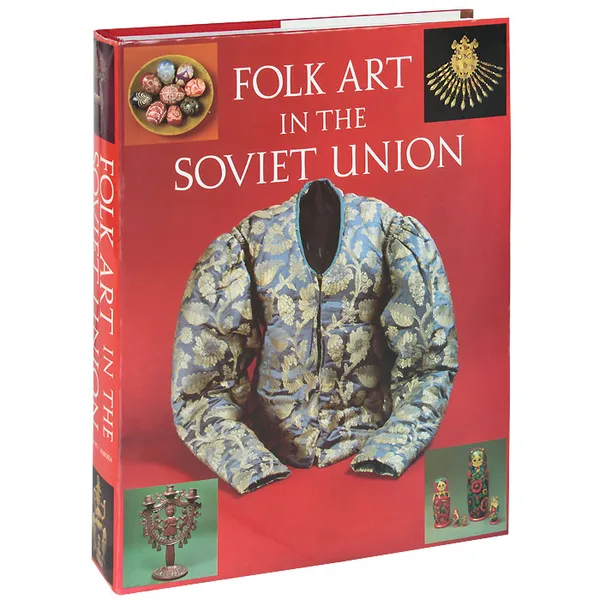Folk Art in the Soviet Union
Издательство: Abrams,Аврора, 1989
460 страниц
Категория: Искусство и культура
ISBN: 5-7300-033-2
Язык: Английский
Букинистическое издание; Цветные иллюстрации
📒 Folk Art in the Soviet Union is the first large, comprehensive survey aimed at providing a panoramic view of folk arts and crafts in the USSR. Never-before-seen objects from every region, from the European border to the Pacific Ocean and from the Arctic to the southern deserts, dating mostly from the nineteenth and twentieth centuries, are presented in this remarkable book. In 1,430 pictures, many in full color, and with a brilliant text accompanied by detailed maps, the richness, variety, and ingenuity of the folk arts of the peoples of the USSR are spread before us, revealing an amazing complexity and skill. In this unique book, the work of many different ethnic groups, each possessing different historical backgrounds, and living in vastly different geographical and climatic regions, are shown.
Handicrafts are an essential element of a nation's culture. They originate from customs, rituals, and practical needs, lending beauty to handmade objects while continuing age-old traditions. Folk artists often use readily available materials, such as clay, wood, bark, cotton, flax, straw, wool, fur, and grasses. Unschooled, they draw on the skills of their ancestors, adding their own techniques and improvisations. This book is a tribute to the thousands of women and men, in a vast territory, who have lovingly created useful, everyday objects of distinction.
The book is divided into five major geographical sectors: the Russian Soviet Federated Socialist Republic, by far the largest; the Caucasus; the Ukraine, Byelorussia, and Moldavia; the Baltic area; and Central Asia and Kazakhstan. These in turn are divided into twenty subdivisions, such as Armenia, Georgia, Siberia, Turkmenia, and Lithuania, among others. Every major geographical area is introduced by a map, a photograph of a typical landscape, and, most important, by an extensive, informative essay giving the historical background of the peoples inhabiting each region and their particular skills. In the largest republic, the Russian Republic, we meet the Mordvinians, Bashkirs, Tatars, Udmurts, Chuvashes, and Maris and their extraordinary embroidery; in the northern Caucasian Mountains pottery, knitting, wood-carving, and goldsmithing are flourishing; in the vast Siberian territory, the Yakuts, Nentsy, Khants, Evenks, and Dolgans ornament their fur costumes and footwear in a highly original fashion, and also use birch bark to make household utensils. In other republics we see sophisticated examples of lace, rugs, skirts, blouses, jackets, belts, boots, wall hangings, towels, headdresses, toys, distaffs, pots and bowls, and jewelry. The techniques used in embroidery, lacemaking, weaving, wood carving, silver- and goldsmithing, paintings, carpetmaking, and pottery are all carefully explained.
The stunning photographs are of objects in the major Soviet museums devoted to folk arts and crafts...
Handicrafts are an essential element of a nation's culture. They originate from customs, rituals, and practical needs, lending beauty to handmade objects while continuing age-old traditions. Folk artists often use readily available materials, such as clay, wood, bark, cotton, flax, straw, wool, fur, and grasses. Unschooled, they draw on the skills of their ancestors, adding their own techniques and improvisations. This book is a tribute to the thousands of women and men, in a vast territory, who have lovingly created useful, everyday objects of distinction.
The book is divided into five major geographical sectors: the Russian Soviet Federated Socialist Republic, by far the largest; the Caucasus; the Ukraine, Byelorussia, and Moldavia; the Baltic area; and Central Asia and Kazakhstan. These in turn are divided into twenty subdivisions, such as Armenia, Georgia, Siberia, Turkmenia, and Lithuania, among others. Every major geographical area is introduced by a map, a photograph of a typical landscape, and, most important, by an extensive, informative essay giving the historical background of the peoples inhabiting each region and their particular skills. In the largest republic, the Russian Republic, we meet the Mordvinians, Bashkirs, Tatars, Udmurts, Chuvashes, and Maris and their extraordinary embroidery; in the northern Caucasian Mountains pottery, knitting, wood-carving, and goldsmithing are flourishing; in the vast Siberian territory, the Yakuts, Nentsy, Khants, Evenks, and Dolgans ornament their fur costumes and footwear in a highly original fashion, and also use birch bark to make household utensils. In other republics we see sophisticated examples of lace, rugs, skirts, blouses, jackets, belts, boots, wall hangings, towels, headdresses, toys, distaffs, pots and bowls, and jewelry. The techniques used in embroidery, lacemaking, weaving, wood carving, silver- and goldsmithing, paintings, carpetmaking, and pottery are all carefully explained.
The stunning photographs are of objects in the major Soviet museums devoted to folk arts and crafts...
Мнения
